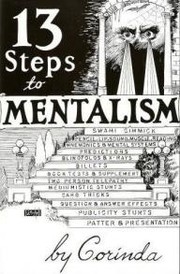13 Step To Mentalism Pdf Download

Author Published 1961 Thirteen Steps to Mentalism is a book on. It was originally published as thirteen smaller booklets as a course in mentalism and was later republished as a book in 1961. The book is now considered by most to be a classical text on mentalism. On the way to success karnevskaya reshebnik. [ ] The book describes various techniques used by to achieve what appear to be such as,,, and the ability to communicate with the dead as a. The book has detailed information regarding,, the construction and use of such devices as the,, and billet pens. Together with 's Practical Mental Effects and T.A. Waters' Mind, Myth and Magick, it is considered [ ] standard literature for any,, or student of who wishes to incorporate into their routine.
Mentalists such as, [ ],, [ ] [ ] and [ ] have relied upon Thirteen Steps To Mentalism for their own mental illusions. Byron sharp how brands grow pdf file free. In 2011 Corinda's Thirteen Steps to Mentalism was republished in the Encyclopedia of Mentalism and Mentalists. References [ ].
This book was originally written as a series of pamphlets for sale in “magic shops” all over the English-speaking world. I should point out here, to avoid confusion, that in this case “magic” refers exclusively to stage magic and not such Magic (or Magick) as people like Aleister Crowley discuss. The book explains, mostly in very practical terms, the array or “tricks,” “gimmicks” or “swindles” (!) one can perform on stage in order to appear to be a mind reader in order to entertain an audience. This book was originally written as a series of pamphlets for sale in “magic shops” all over the English-speaking world.
13 step to mentalism pdf: User’s review: Same-sex sexual activity is legal in all eu states. Deceits and illusions. Lgbt rights in the european 13 step to mentalism pdf.
I should point out here, to avoid confusion, that in this case “magic” refers exclusively to stage magic and not such Magic (or Magick) as people like Aleister Crowley discuss. The book explains, mostly in very practical terms, the array or “tricks,” “gimmicks” or “swindles” (!) one can perform on stage in order to appear to be a mind reader in order to entertain an audience. Most of these pamphlets were originally written in the late 1950s or early 1960s, and as the author is British, there are some interesting (at times confusing) anachronisms or foreign terms to grapple with, for example when he speaks of any trick involving currency. There are also many typos and writing errors of various kinds, although the editors have done a good job of making page references consistent to the book’s pagination, instead of for example referring you to “page 8 of step three.” Probably because of its history as a series of booklets, the front end of the book is heavily weighted toward practical advice, and the back is where most of the theory is covered.
If you’re not interested in the history of stage magic, this book still has a few interesting sections, especially those in which he reveals how “phony mediums” put on their performances. It’s also interesting, from an ethical standpoint, how disapproving he is of “phony mediums” and others who use these techniques to rip people off instead of entertain them. It’s interesting in part, because the whole conceit of his act, and everyone else involved in this business, is to pretend that mind reading really is possible, and that these staged tricks demonstrate it, while throughout the book he is clearly telling you it isn’t, and how you can guess a card or number without being a real mind reader. The last two chapters are also interesting, in terms of the advice he gives on publicity and self-promotion, though of course he is dealing with a different level of communications technology than is normal today. More broadly, what is interesting about this book is the ways it demonstrates how easily people can be fooled, how ready they are to be fooled, and how a smart individual can take advantage of that.